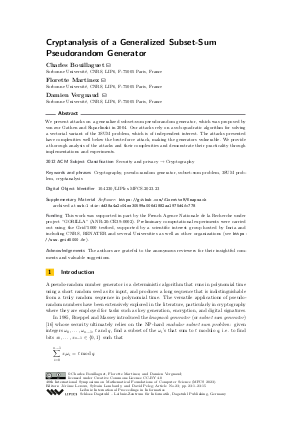@InProceedings{bouillaguet_et_al:LIPIcs.MFCS.2023.23,
author = {Bouillaguet, Charles and Martinez, Florette and Vergnaud, Damien},
title = {{Cryptanalysis of a Generalized Subset-Sum Pseudorandom Generator}},
booktitle = {48th International Symposium on Mathematical Foundations of Computer Science (MFCS 2023)},
pages = {23:1--23:15},
series = {Leibniz International Proceedings in Informatics (LIPIcs)},
ISBN = {978-3-95977-292-1},
ISSN = {1868-8969},
year = {2023},
volume = {272},
editor = {Leroux, J\'{e}r\^{o}me and Lombardy, Sylvain and Peleg, David},
publisher = {Schloss Dagstuhl -- Leibniz-Zentrum f{\"u}r Informatik},
address = {Dagstuhl, Germany},
URL = {https://drops.dagstuhl.de/entities/document/10.4230/LIPIcs.MFCS.2023.23},
URN = {urn:nbn:de:0030-drops-185579},
doi = {10.4230/LIPIcs.MFCS.2023.23},
annote = {Keywords: Cryptography, pseudo-random generator, subset-sum problem, 3SUM problem, cryptanalysis}
}

 Creative Commons Attribution 4.0 International license
Creative Commons Attribution 4.0 International license










